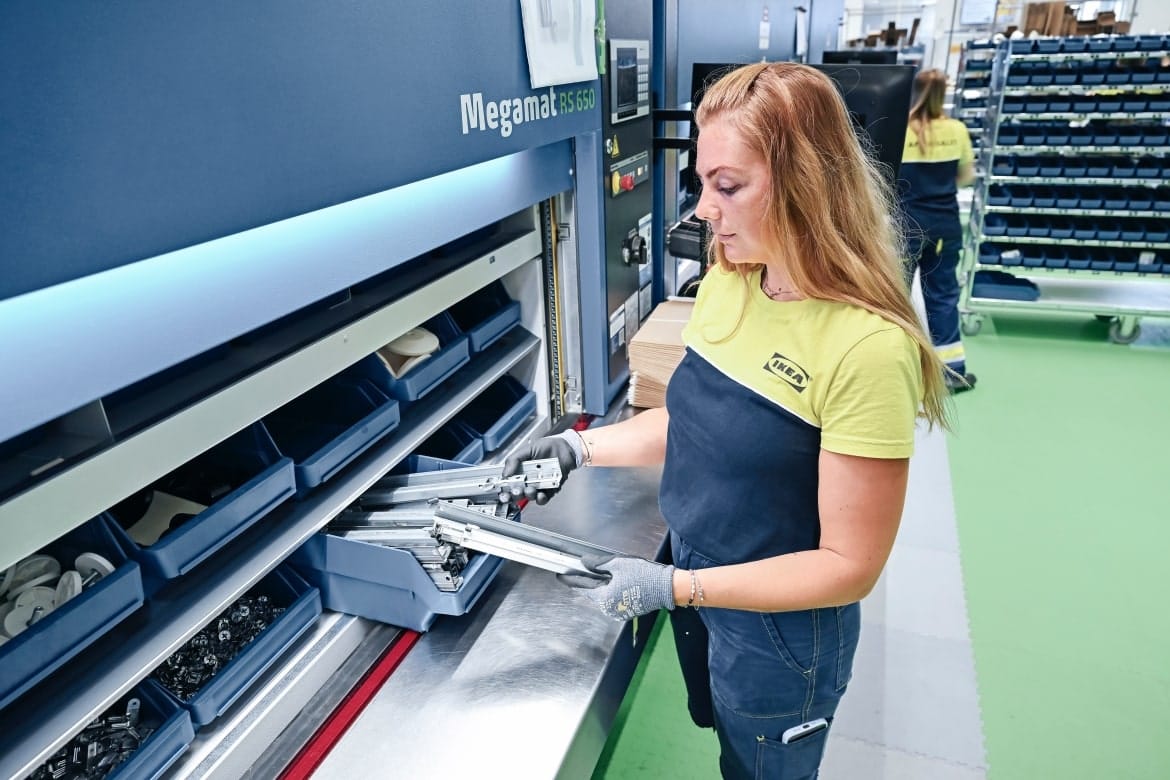How e-commerce businesses can optimize warehouse operations to stay competitive in 2025
- January 4, 2025
- News

1. Introduction: The shifting landscape of e-commerce and intralogistics challenges
How e-commerce businesses can optimize warehouse operations to stay competitive in 2025. The e-commerce industry has transformed dramatically over the last few years, driven by rapidly evolving consumer expectations and technological advancements. From the surge in demand for same-day deliveries to managing fluctuating order volumes, the pressures on e-commerce businesses to streamline their warehouse operations have never been greater. For e-commerce professionals in the DACH region and beyond, staying competitive means embracing innovative intralogistics solutions that optimize processes, improve efficiency, and enhance customer satisfaction.
In this article, we’ll explore the most common intralogistics challenges faced by e-commerce businesses, the role of automation in overcoming these challenges, and practical steps to optimize warehouse operations.
2. Common challenges in e-commerce fulfillment
2.1 Rising demand for faster deliveries
Consumers are no longer satisfied with 3-5 day shipping windows. According to a 2022 report by McKinsey & Company, 90% of online shoppers expect next-day delivery, and 30% expect same-day delivery.
The rise of giants like Amazon has set new benchmarks for delivery times, with next-day and even same-day delivery becoming the norm. This trend is particularly pronounced in the DACH region, where customer expectations are high, and competition is fierce.
Wholesale, retail, and e-commerce companies are increasingly under pressure to fulfill orders quickly while maintaining accuracy. Traditional “person-to-goods” order picking methods are struggling to keep up with these demands, especially as product portfolios expand and orders become more frequent (Forrester Research, 2021).
Managing seasonal peaks and fluctuating order volumes
E-commerce businesses often face unpredictable spikes in demand, especially during holidays, sales events, and seasonal changes. These peaks can overwhelm traditional warehouse systems, leading to delays, errors, and dissatisfied customers.
Efficient intralogistics solutions must be flexible and scalable to handle these fluctuations without compromising on performance (Deloitte, 2022).
2.2 Handling returns effectively
The rise of online shopping has also led to an increase in product returns. A study by the National Retail Federation (NRF) found that returns accounted for 16.5% of total retail sales in 2022, costing businesses billions annually. Processing returns is a labor-intensive task that can create bottlenecks if not managed efficiently. Manual handling of returns can lead to delays, errors, and additional costs.
2.3 Warehouse space constraints
Limited warehouse space is a significant challenge for many e-commerce businesses. According to a 2023 report by CBRE, warehouse vacancy rates in Europe are at a historic low of 2.4%, making efficient space utilization critical. As the number of SKUs (Stock Keeping Units) grows, traditional shelving and storage systems can quickly become inefficient. Optimizing space while maintaining accessibility is essential for efficient operations.
2.4 Shortages and Labor CoStaffsts
Finding and retaining skilled warehouse staff is becoming increasingly difficult. The International Labour Organization (ILO) reported that labor shortages in the logistics sector increased by 25% in 2022. Rising wages and high turnover rates are putting additional strain on e-commerce operations. Automating repetitive tasks can help mitigate these challenges by reducing dependency on manual labor (PwC, 2022).
3. The importance of smart intralogistics solutions
To address these challenges, many e-commerce businesses are turning to automated intralogistics solutions. Automation can enhance speed, accuracy, and efficiency, giving businesses a competitive edge.
Kardex, a global leader in intralogistics solutions, offers a range of automated systems that are designed to meet the unique needs of e-commerce operations. Let’s look at a few customer success stories that demonstrate the power of automation in solving common warehouse challenges.
3.1 Ikea Components: Streamlining global distribution
IKEA Components s.r.o., a distributor of furniture fittings and part of the Inter IKEA Group, faced challenges with low picking efficiency and inefficient use of time and human resources in their warehouse in Slovakia. This warehouse distributes missing parts to customers worldwide.
By implementing six Kardex Megamats, four Kardex Shuttles, and integrating the Kardex Power Pick System with Infor M3 and ASAP, they improved efficiency with the Kardex Color Pick System and achieved the following results:
- Faster and more accurate picking
- 8 operators pick 11,000 items per day
- 6,000 items in stock
This solution significantly enhanced efficiency, accuracy, and productivity, allowing IKEA Components to better serve customers globally. For more information, visit the Kardex website (Automated storage systems Kardex Megamat and Kardex Shuttle in IKEA Components s.r.o.).

How e-commerce businesses can optimize warehouse operations
Source: Kardex
3.2 Bleckmann: 60% reduction in order cycle time for e-commerce logistics
Bleckmann, a global logistics partner specializing in e-commerce and fashion fulfillment, faced challenges with growing order volumes and the need for faster order cycle times. To address these issues, they implemented an AutoStore solution from Kardex, streamlining their warehouse operations in Belgium (Bleckmann reduziert mit AutoStore seine Auftragsdurchlaufzeiten um 60 %).
By integrating the AutoStore system, they achieved the following results:
- 60% reduction in order cycle time
- Improved efficiency in picking and packing processes
- Optimized warehouse space utilization
This automation enabled Bleckmann to handle increasing e-commerce demand while significantly improving delivery speed and operational efficiency.


How e-commerce businesses can optimize warehouse operations
Source: Kardex
3.3 Vihamij: Boosting order processing in wholesale
Vihamij, a Dutch wholesaler of building materials with 36 nationwide stores and an e-commerce sales channel, faced challenges with increasing order volumes and inefficient storage systems. To streamline their operations, they partnered with Kardex to implement automated storage solutions(Case Study: Vihamij / Case Study Vihamij | Faster Order Processing).
By installing three 12-meter high Kardex Miniload systems with turntables and LED pointers, Vihamij achieved the following results:
- Reduced labor resources and travel time
- Increased order processing efficiency
- Higher throughput and fewer picking errors
This automation allowed Vihamij to keep up with growing demand while improving accuracy and reducing costs.

Source: Kardex

Source: Kardex
4. Key benefits of automation in e-commerce
These Consumer Success Stories show that automation offers several key benefits for e-commerce businesses:
- Optimized Space Utilization: Automated storage systems can significantly reduce the warehouse footprint, allowing businesses to store more products in less space.
- Increased Order Fulfillment Speed: Automation accelerates picking, packing, and shipping processes, enabling faster deliveries to meet customer expectations.
- Improved Accuracy: Automated systems reduce picking errors and improve inventory accuracy, leading to higher customer satisfaction.
- Reduced Labor Dependency: By automating repetitive tasks, businesses can mitigate labor shortages and reduce operational costs.
- Scalability and Flexibility: Automated solutions are scalable, making it easier to handle seasonal peaks and fluctuating demand.
- Efficient Returns Handling: Automation streamlines the returns process, reducing bottlenecks and improving efficiency.

Source: Kardex
5. Practical steps to implement automation
If you’re considering automating your e-commerce warehouse operations, here are some practical steps to get started:
5.1 Evaluate current operations
Identify pain points in your current processes, such as bottlenecks, inefficiencies, and space constraints. Conduct a thorough analysis to determine where automation can have the most impact.
5.2 Select the right solutions
Choose automated storage and retrieval solutions (ASRS) that align with your business needs. Options like Kardex Shuttles, Miniload systems, and pick-to-light technology offer flexibility and efficiency.
5.3 Integrate with existing systems
Ensure that your automated systems integrate seamlessly with your Warehouse Management System (WMS) and Enterprise Resource Planning (ERP) systems for streamlined operations.
5.4 Train your workforce
Provide training for your staff to ensure they can effectively operate and maintain the new systems. Modern automated solutions are designed to be intuitive and require minimal training.
5.5 Plan for future growth
Choose scalable solutions that can grow with your business. Consider future expansions, new product lines, and changes in customer demand.
6. Conclusion: Future-proofing your e-commerce business
The future of e-commerce lies in smart, automated intralogistics solutions. As customer expectations continue to rise and competition intensifies, optimizing warehouse operations is no longer optional – it’s a necessity. By investing in automation, e-commerce professionals can improve efficiency, reduce costs, and deliver exceptional service to their customers.
Embrace the power of automation to stay ahead of the curve and future-proof your e-commerce business in 2024 and beyond.
Find out more about Intralogistics for Retail, Wholesale, E-Commerce: https://cdn.bfldr.com/EL3HU3A3/at/qbs7nfq6qsbt3trcx6mhmrw/IndustryBrochure_EN_E-Commerce
10 Proven Shopify Marketing Strategies for Beginners ~ Dropship News












